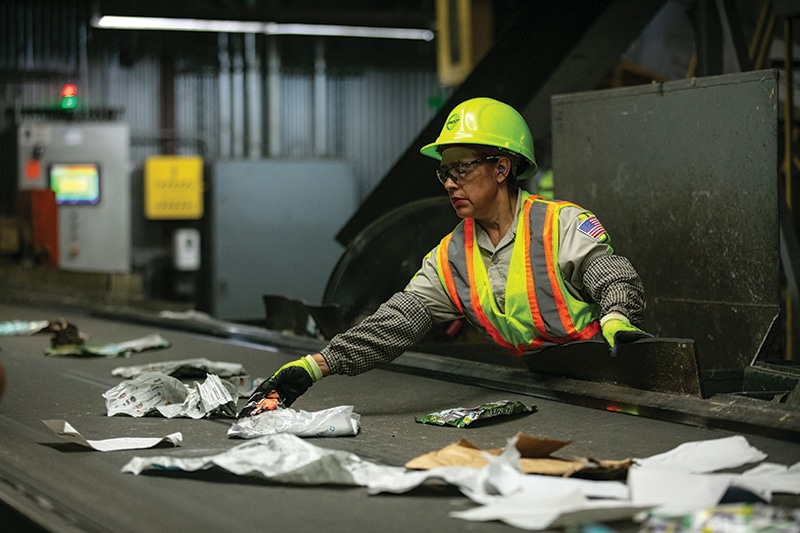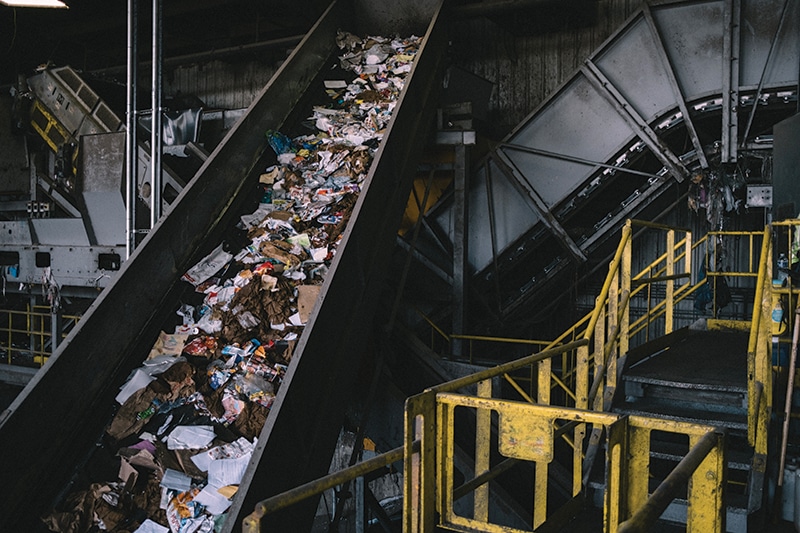But When It’s Done Right, It’s Good for Everyone
When a Groot recycling facility in Plainfield burned down in 2021 due to a battery fire, no one could blame Davide Pezzini for it.
Like an estimated 20% of people, Pezzini, a 46-year-old Chicago resident and professional bass player, is fastidious about recycling. He grew up in Switzerland, and while he was in elementary school, the country began to foster a recycling culture. He learned to separate waste — glass, paper, tin, aluminum, electronics, compost, batteries, and plastic — into different piles.
“Every Saturday, my family and I would take all of our separated waste and put it into the corresponding piles at the city facility,” he says. “To this day, I can’t throw a battery away. I have this giant box of dead batteries at my house that I don’t know what to do with. I want to do the right thing and keep them out of a landfill, but what can I really do?”
Can he recycle them? No. Could he take them somewhere to be recycled, such as Home Depot? No, because Home Depot only takes rechargeable batteries.
If you want to help the environment, you’ll have to pay a company like Call2Recycle a minimum of $55 to ship them to their recycling facility.
Still, despite the battery obstacle, Pezzini finds the recycling system in the U.S. much simpler.
“One bin for all the recyclables is definitely more user-friendly,” he says. “But to be honest, I don’t know what happens to it after it leaves the curb.”
Pezzini raises an important question: Where does it all go? And what impact does our waste have on people’s health — both the community at large and people who work in recycling facilities and handle things like leaky batteries?
Researchers with the Better Government Association wondered the same thing. In 2018, they reported that Chicago’s recycling rate was a paltry 9%. That figure represents all of Chicago’s waste: standard garbage plus the contents of the blue bins.
Out of sight, but inside of us
Unlike the era of Charles Dickens — or even Chicago as recently as the 1990s, when construction companies commonly did illegal fly dumping on the west and south sides — we don’t see giant piles of trash on our streets. After your waste gets hauled away each week, it either goes to a recycling facility or a landfill. While it ceases to be your household problem, it can have severe impacts on your health and the environment.
Organics, like last week’s uneaten leftovers, make up a large portion of the waste stream. This type of waste decomposes anaerobically, or without oxygen, in landfills; as it breaks down, it produces large amounts of methane gas — a major contributor to climate change.
If you care about the environment, you’re probably plagued by existential dread while trying to figure out how to dispose of your potato peels and other food and yard waste. Because of the amount of water they contain, “organics can represent 30 to 60% by weight of waste streams depending on the region, economics, culture, and other factors,” says Peter Lobin, a Chicago-based consultant with a long history in waste and recycling.
This organic waste could be turned into nutrient-rich compost, but in Chicago, unless you have a backyard composter or subscribe to a private composting service, it will go into a landfill. Though, Chicago has started a composting pilot program. The Department of Streets and Sanitation has partnered with nonprofit land trust NeighborSpace on six community garden compost sites.
Polystyrene, commonly though incorrectly known as styrofoam, is a large component of landfill volume in Illinois. Scientists estimate that this nasty little bugger takes anywhere from 500 years to thousands of years to fully decompose. Meanwhile, scientists have linked the chemicals that leach from polystyrene foams into food and water sources with a litany of health problems, including nervous and digestive system issues and cancer.
Then there’s plastic. The particles that leach from plastic waste are in our bodies, too. In 2019, researchers at the University of Newcastle, in Australia, concluded in a study that people worldwide ingest approximately 2,000 tiny pieces of plastic a week, about five grams in weight, mostly through water but also through the food chain. Put another way, that equals nearly a credit card’s worth of plastic, every week, in all of us.
Even human placentas have been found to contain microplastic particles, which researchers suspect could disrupt normal immune system functioning, among other health effects.
Recycling offers a way to keep plastics and other waste out of the environment, but historically it’s been tough on workers.

“Recycling workers face a number of health and safety hazards….Bleach, battery acid, paint, paint thinner, inks, dyes, razor blades, and homemade explosives are in the waste stream….Garbage and recycling workers are regularly exposed to these substances,” wrote David Naguib Pellow in his 2002 book Garbage Wars: The Struggle for Environmental Justice in Chicago.
A work in progress
Cities began recycling around the first Earth Day, in 1970. The movement emerged from opposition to the the Vietnam War, Rachel Carson’s landmark environmental science book Silent Spring, and several ecological disasters, including a major oil spill off the coast of Santa Barbara in 1969.
For decades, China paid the U.S. for its recyclables, in order to turn the material into new products. In 2017, China stopped accepting them because of the difficulties in recycling much of the imported materials, and the pollution and toxins they brought into the country. Because the U.S. didn’t have a system in place to handle such a massive volume of material, it created a backlog of recyclables with nowhere to go. The costs to process the material were high, and cities weren’t committing to the new expense. As a result, most of the U.S.’s recycling went into domestic landfills. While some companies purchased the recycled paper products, some types of plastic, and metals, there was a near-25% increase in the amount of plastic going back into U.S. landfills, a 2022 study from the University of Buffalo showed.
Landfill costs are greater on the west and east coasts. “The reason for the high costs is either the distance required to move the waste to a landfill or the state is more environmentally oriented,” Lobin says. Yet, older cities, such as Chicago, also see high rates. “Keep in mind older larger cities are going farther and farther out to reach landfills,” Lobin says. For example, the recycling rate in San Jose, California is around 75%, and the cost to dump waste there ranges from $57 to $87 per ton. In Iowa, the base fee to dump is $4.25 per ton; Illinois charges more, at $52.
LRS (formerly Lakeshore Recycling) began handling waste and recycling for Chicago in 2021. The fully integrated waste and recycling company with a mission of recycling and reusing as much waste as possible rather than landfilling it. Still, in 2022, the city reported an average recycling rate of 9.63%, with the highest rate (11.53%) in February of that year.
Even though there’s much room for improvement, about 80% of the material put into blue bins is recycled, says John Sliwicki, executive vice president in LRS’s central region. “I have about 300 tons a day that we process as a company from Chicago, and we recycle 80% of that.”
Groot, which handles 23 communities north and west of Chicago, also reports processing about 80% of the 500 tons of material they handle.
Is this recyclable?
Javier Erazo, district manager at Groot, says that in his experience, customers typically follow a bell curve when it comes to recycling: 20% are fastidious, 60% try to get it right but aren’t always sure, and the other 20% appear indifferent.
“There’s a huge misconception that just because something is made out of plastic, metal, or glass, that it belongs in a recycling bin.”
LRS, Groot, and the city of Chicago all say consumer education is vital to improving recycling. However, visible signs of public education from these organizations are scant. As a result, consumers are left to decide whether their waste can be recycled.
Visit chicagorecycles.org, Chicago’s educational page on recycling, and you’ll see lots of information on the importance of recycling. But you have to hunt for direct information on what you should and should not put into a blue bin, or how to recycle and dispose of other unwieldy or hazardous objects such as old sofas, paint, electronic waste, and batteries. The information is posted on blue bins, but it’s often torn, dirty, or difficult to see.
However, the city is working on a new, in-depth, and easily accessible educational program, according to a spokesperson, and should roll out by the end of 2023.
Often, people engage in wish-cycling, trying to recycle what they think should be recyclable, or what they wish they could recycle, such as rubber garden hoses or plastic film. “There’s a huge misconception that just because something is made out of plastic, metal, or glass, that it belongs in a recycling bin. That’s just not the case,” Erazo says.

Consumers sometimes toss products that are dangerous into their recycling bins, such as lithium ion batteries or empty propane tanks. Other unsafe products are routinely dumped in the blue bins — anything from used syringes to soiled diapers because they have been marketed with a recycling logo stamped on them, even if they’re not truly recyclable.
“Having dangerous materials like these can be a health hazard to our employees managing this waste stream,” Sliwicki says.
The most commonly recycled plastics, #1 PET and #2 HDPE are recycled most, Lobin says. They have the greatest chance of being turned into another product, like a detergent or water bottle, or be turned into an entirely different product altogether, such as a t-shirt.
Plastics numbered 3 through 7 are less likely to be recycled, because economically they cost more and physically are more difficult to recycle.
The way forward
Identifying a starting place to improve recycling efforts feels a bit like looking at the famous Spiderman finger-pointing meme, with everyone assigning someone else to start the job. But to slow the tide of inevitable health and environmental impacts, state and local leaders need to evaluate possible solutions to improve the system.

Last year, Illinois passed a bill that banned state agencies from using disposable food containers made of polystyrene foam. Currently, a pending bill would prohibit the sale or distribution of disposable food service containers composed in whole or in part of polystyrene foam. Jennifer Walling, executive director of the Illinois Environmental Council, sees these bills as a positive sign that Illinois is getting serious about recycling and waste reduction.
“I couldn’t have imagined passing that sort of bill [to ban Styrofoam for state facilities and universities] 10 years ago,” she says. “We’ve built enough political pressure to move this forward.”
In fact, Illinois Senate Bill 1555, passed in June 2023, requires producers to be more responsible in packaging, and to establish programs to prevent waste and encourage reuse and composting, as well as requiring them to publish lists of readily recyclable materials.
“It’s a first step to get at some of the systemic flaws in our waste system,” Walling says.
Chicago’s Department of Streets and Sanitation is also looking at ways to reduce organic waste, according to Chris Sauve, the department’s deputy commissioner. “That’s going to be a major game-changer for the way we do recycling in the city and how we can improve the overall diversion number,” he says.
In fact, a 2021 study from the University of Illinois at Chicago suggests that an organic waste program for single-family homes in Chicago could divert 18% of waste away from landfills, lessening methane production as well.
“Everything is recyclable, but not everything is economically recyclable,” Lobin says.
Lobin believes that cities should look at the waste stream as a resource, not as a line item expense for disposal.
For example, recycling companies themselves could take raw recycled material, such as tuna cans, and manufacture aluminum-based products, such as broom handles or new cans, instead of selling that material to a third-party outlet. Plastic Recycling of Iowa Falls provides a model municipalities could follow. They take recycled plastic and turn it into nearly indestructible plastic tables, benches, and other products.
There’s not one single lever a city or a waste management company can pull to overhaul the recycling system. To do recycling right is complicated, but there’s tremendous potential for it to be something more than a line item in a city’s budget. Recycling can provide the raw material to create new products, which in turn, could spur local economic growth. And crucially, recycling can be a key cog in keeping communities healthier and the planet cleaner. Now if only Pezzini could find a solution for all of the batteries he’s been saving.
Above photo by Jim Vondruska
Originally published in the Fall/Winter 2023 print issue.

Dan Dean is a writer, cancer survivor, and founder of Cancer Dudes, which supports men after being diagnosed with cancer.

Ronit Rose is a freelance writer, based in Chicago. She has a special interest in health, healthcare and preventive medicine.












